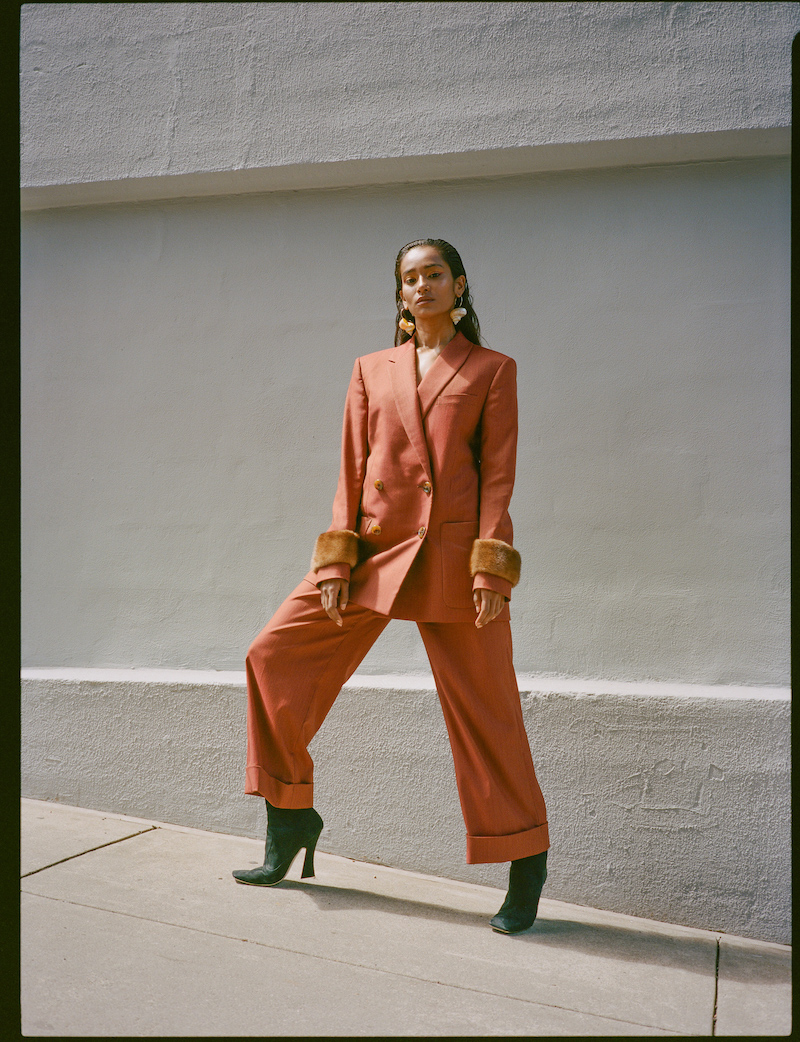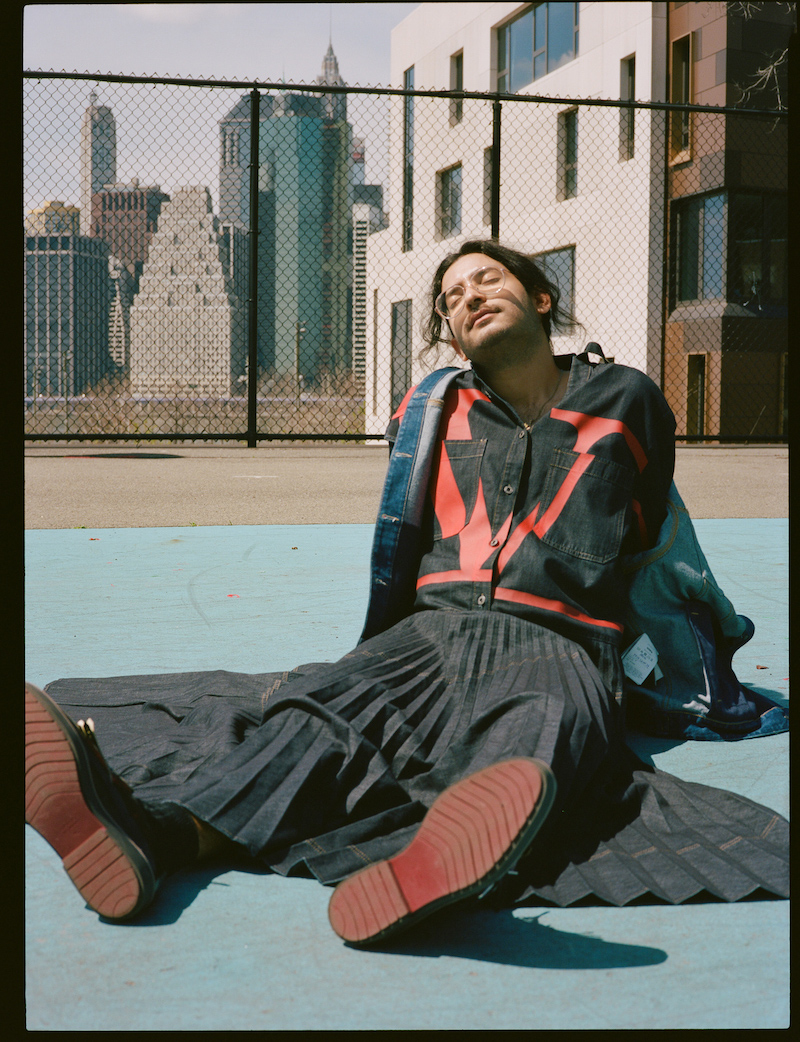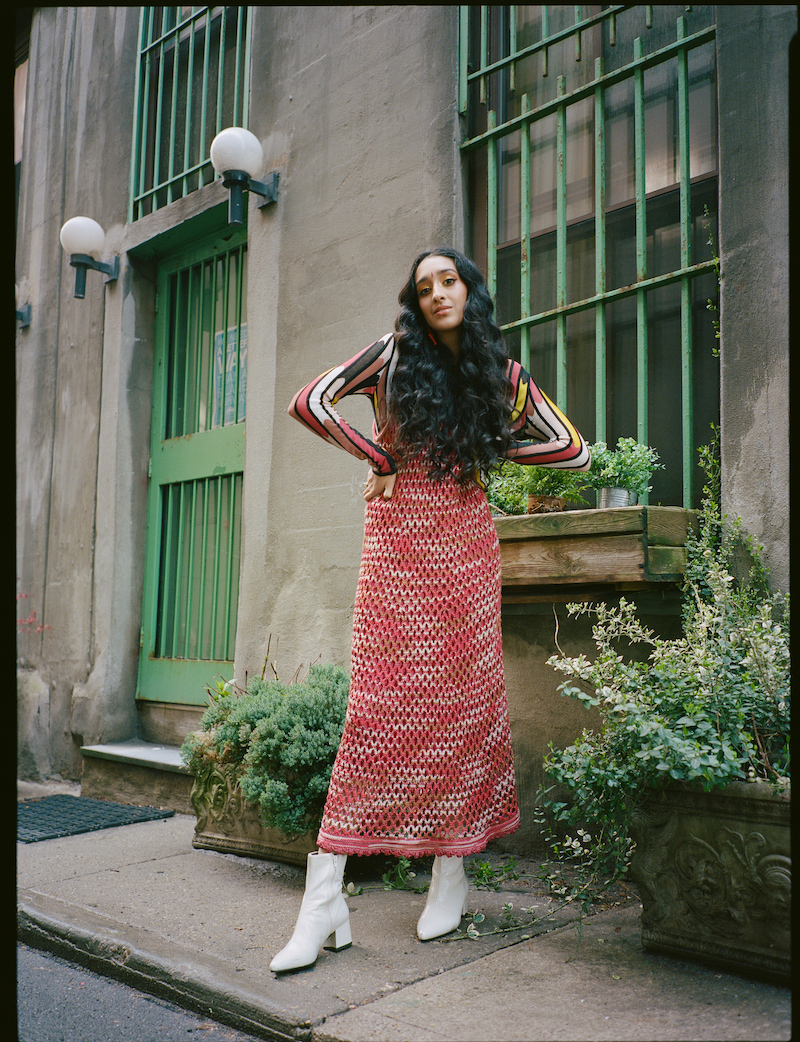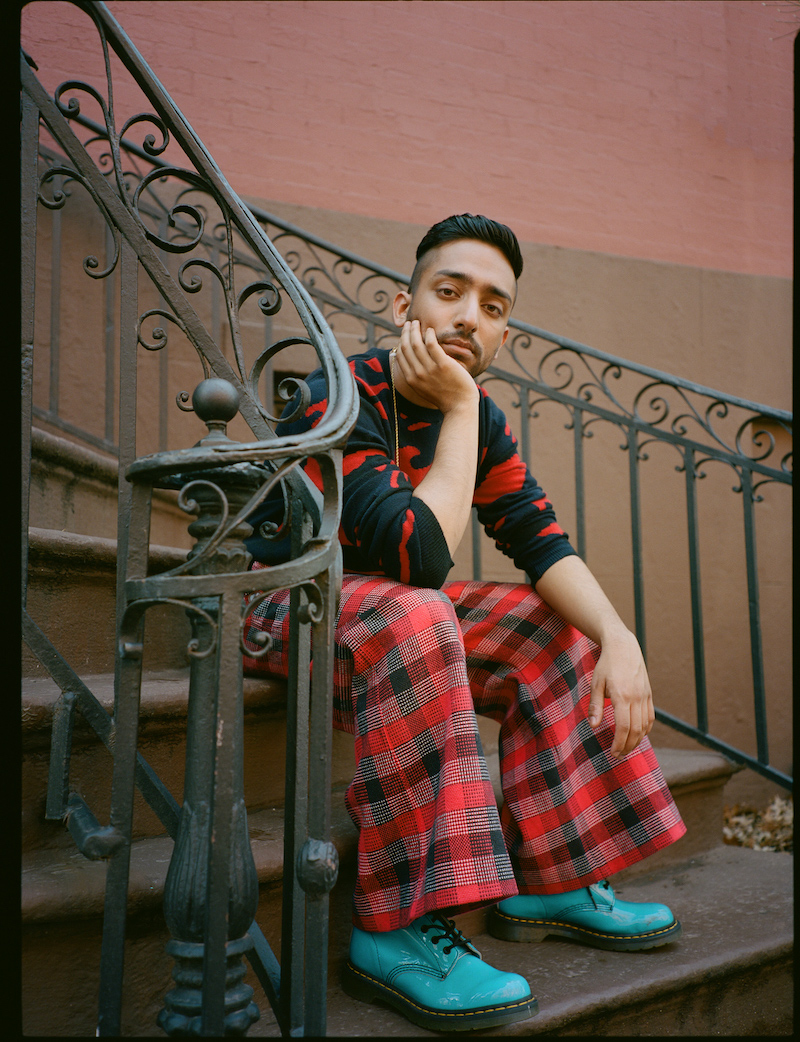Four South Asian Creatives Redefining The Norm
Nidhi Sunil, Mohammed Fayaz, Raveena Aurora, and Mayukh Sen offer insights into their creative journey and navigating identity.
“I want to be part of a new generation of artists that makes space for stories that haven’t been heard”, said musician Raveena Aurora, one of the four artists on our radar, determined to create art that is not only empowering but also on her own terms. Nidhi Sunil, Mohammed Fayaz, Raveena Aurora, and Mayukh Sen are four of the many emerging brown South Asian creatives creating awareness about mental health, colorism, solidarity and making space for marginalized voices through their creative practices.
NIDHI SUNIL, Model

Suit and boots by Fendi
Earrings by Luiny
How different have your experiences been working in Mumbai and New York as a model?
When I started modeling in India, we were (and still are generally) obsessed with fair skin and it’s the more bankable commodity. My first agent wanted me to get laser surgery to remove my freckles so that clients would consider me for commercial work. So I just created content for free with friends, photographers and other creatives until I booked my first editorial and magazine cover and eventually campaigns. As much as I found being dark skinned was unattractive and generally not aspirational back home, in New York I felt ‘exotically beautiful’ though that didn’t guarantee campaigns either.
Do you have any favorite shoots or moments on set you will never forget?
Well my first cover back home for Elle where they put two very dark-skinned girls on the cover was really special. I felt like I got to be a part of something that was bigger than myself. I honestly didn’t even understand it at the time. The first time I shot with Vogue was special. That time my work visa to the United States was approved was special. These things felt like mountains to a middle class Indian girl until I found I’d crossed them. My Grandfather still thinks I’m basically a prostitute though.
How have you navigated issues regarding colorism in India?
I navigated it amongst other things by choosing to like myself. I just heard a lot of No’s and I decided to respond with curiosity and creativity. Just create, work, live and love. Even in the south of India where people tend to be darker than they are lighter-skinned, my nickname in school was ‘Kalia the crow’. Can you believe there is actually a report called the “India Fairness Cream & Bleach Market Overview,” that anticipates the women’s fairness cream category in India to earn 5000 Indian crore by 2023. I wasn’t really surprised when I got intensely trolled about how ugly I was or average I was because of my skin color. Besides I always see things as veiled blessings, because it forced me to talk about my experiences and it made me realize there were a ton of women out there who resonated with them. It’s been amazing to make brown girl friends over the internet.
What advice do you have for young women getting into the modeling industry?
To never stop being creative. To not think about the money so much as the experience and growth. To help and support the other girls and not see them as competition. To realize that it’s really not just about being pretty.
MOHAMMED IMAN FAYAZ, Illustrator

Dress & Jacket Valentino
Shoes model’s own
How did you start practicing illustration?
I’ve been drawing my whole life, but it took me many years to realize that my talent didn’t have to be a hobby saved for nights and weekends but could be what I dedicated my life to.
You’re a part of ‘Papi Juice’, an art collective that supports queer and trans people of color, tell me more about your experiences and how this came about.
I had been attending the first few Papi Juice events back in Summer 2013, and as this community grew it made sense to the organizers to bring in my artwork to bring together the visual story. I joined the crew full-time a few months later and we’ve been going strong for 6 years. I’m now our creative director.
How do you choose your subjects for your illustrations? What inspires you?
I’m inspired by the small, the sweet, and the intimate. It’s the way two best friends can have a whole conversation with their eyes, the way a lover wakes up moments before you in the morning, and inside jokes from 10 years ago.
What message do you want people to take away from your illustrations?
I’m very interested in solidarity; it’s not enough that our communities unite only against hatred but also actively, positively, and rewardingly engage and build with one another. As much as we are resistance, we’re also growth, and nurturing, and care, and big bountiful love. It might feel corny but in practice, it’s the most powerful thing that I know to be.
RAVEENA, Musician

Blouse and dress by M Missoni
Boots model’s own
Tell me more about your songwriting process. What inspires you?
My songwriting process is pretty confessional and I try to write always from reflection on real life experiences or situations I observe. Writing from a meditative and loving space is very important to me – I need quiet and complete alone time. I write music with a very small group of people and usually with Everett, my producer, out of the room if a song idea comes to me. I like to travel and be in nature, to set up situations where I can be in deep states of flow so that when I write a song, the heart of the song all kind of comes to me in an hour or so.
How important is it for you to incorporate your cultural background and queer identity in your work? What are some challenges have you faced?
Spiritually, it’s really important to me to live completely in my truth and completely embrace every part of my identity – I think it’s the path to liberation and understanding of the self. I feel like I was sent so many subliminal messages as a kid and teen that certain parts of my identity – being brown, being Sikh, being queer, my vulnerability and unique sense of femininity – were parts of my identity that I should try to hide, in favor of assimilation into white cis culture. I want to be part of a new generation of artists that makes space for stories that haven’t been heard. Some challenges I’ve faced in music as a south asian woman in music is blatant sexism, racism & sexual harassment, flatly being denied from major labels because of my race, and an overall feeling like there was no place of belonging for someone like me in music; simply because there were so few contemporary examples. I really think things are looking up though, and turning around, and this definitely the best moment to be queer and brown and making art, and new communities and spaces for people like us are forming everyday. It’s such an exciting time!
What can you share about your upcoming album ‘Lucid’?
It’s coming soon, and I’m so incredibly proud of what we made this last year and excited to share it with the world. I feel like it’s going to show people new sides of my life experiences and musical capabilities and give the people who listen to my music a better understanding of who I am as a person and artist. It’s also just a really fun album to listen to and meant to be a concept album to listen to, front-to-back. There was an immense amount of love put into it by me, Everett (my producer), and my bandmates and other friends who worked on this album!
You often talk about self-love and self-care on Instagram. What are some things you have been doing lately to feel balanced and energized?
Meditation is always a must for me, if I can work it into my day. Also therapy is a pretty important part of self-care for me, and I feel very blessed that I can afford it now. I think it’s a treatment everyone should have the privilege to get for themselves if they want to, and not enough people have access. I haven’t had much time for it lately and it’s definitely driving me a bit crazy that I haven’t been able to, but I’m really looking forward to the spring and summer and having more time to take nice walks outside in the sun and plan little trips to nature. Spending time in the sun and in nature is vital and anytime I get back into the habit of having that in my life, I realize that this exactly what I was meant to do as a human. I was not meant to be crouched in front of my computer and phone or holed up in a studio – I was meant to be free and light and soaking in the beauty of this planet.
MAYUKH SEN, Food Writer

Sweater by Valentino
Necklace by Kichu
Trousers & shoes model’s own
How did you fall into the practice of food writing?
I fell into it by chance, I grew up wanting to be a film critic. In the summer of 2016, I was approached by a site called Food52. They had an opening for a full-time Staff Writer, and they wanted someone who wasn’t a home cooking enthusiast (I’m a terrible cook!) to take on this job and reach a new audience. I started writing about subjects who’ve been forgotten or misunderstood (many of them women of color), and I did my best to resurface their legacies. Last year, I won a James Beard Award (the “Oscars of food,” for lack of better term) for a piece I wrote for Food52 in 2017, on the missing soul food icon Princess Pamela.
Does your queer and south Asian identity influence your writing practice? Have you experienced any challenges in terms of navigating your identity when it comes to your writing?
I’d say my queerness and my South Asian identities inform my writing in oblique rather than overt ways nowadays. I wrote many personal essays during my first few months of being a food writer, when I was constantly looking inside myself and exhausting every food narrative I could possibly find within my own life. This resulted in pieces like the one where I wrote about reclaiming fruitcake, which had become both a gastronomic and homophobic slur in America, a phenomenon I found puzzling as someone who’d grown up loving fruitcake, thanks to a dad who ate it quite a lot in in Kolkata. I never quite considered my queerness and South Asian identity in tandem through the prism of food before writing that piece.
But as I developed as a food writer, I grew less interested in myself as a subject and started gravitating towards people in food who were, like me, outsiders in some way. I used that initial point of identification I felt with these subjects—this shared sense of marginalization that I felt from being queer, South Asian, a child of immigrants—as a starting point for my reporting.
You mentioned you’re writing a book for immigrant women and food. Can you tell me more about it and how it’s coming along?
I’m writing a book of narrative nonfiction, to be published by W.W. Norton & Company, about seven different immigrant women throughout American history who’ve shaped food culture in America. Some are no longer with us; a few are still alive. These chapters, each 10,000 words long, are much longer than any piece I’ve ever written. I’m teaching myself how to sustain a narrative over that much terrain. I’m lucky to have time to focus solely on the book for the next few months. I’m also very excited that the great producers have optioned the rights to the book for a documentary series, forcing me to think of the topics in my book beyond the written word.
What are some of your favorite places to eat in New York?
I’m always terrible at answering this question! I try to eat widely and not to go to the same place more than once. Some recent meals I’ve enjoyed have been at King in SoHo, Uncle Boon’s Sister in Nolita, Superiority Burger in the East Village, and Awash in Cobble Hill. But I’ll keep it simple—I’ve never disliked a slice from Best Pizza in Williamsburg.